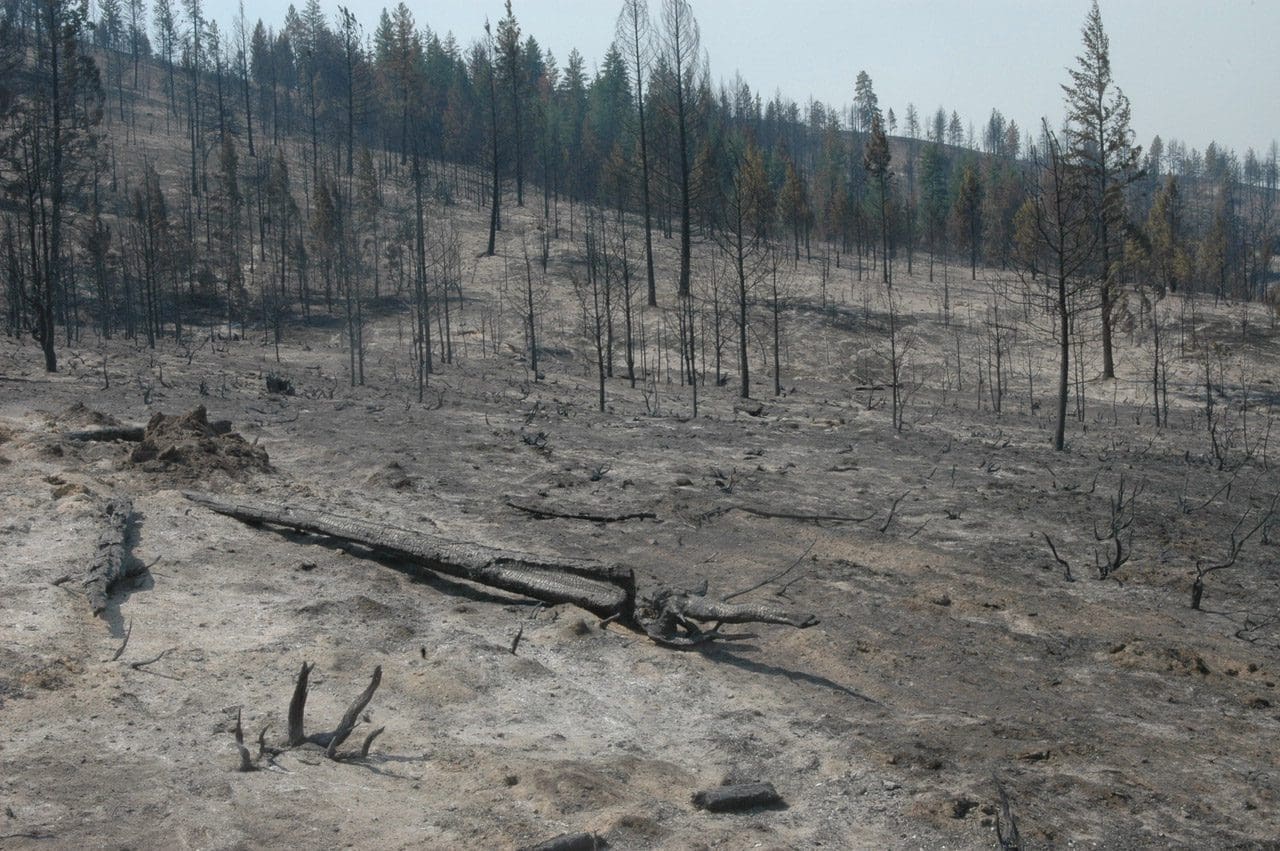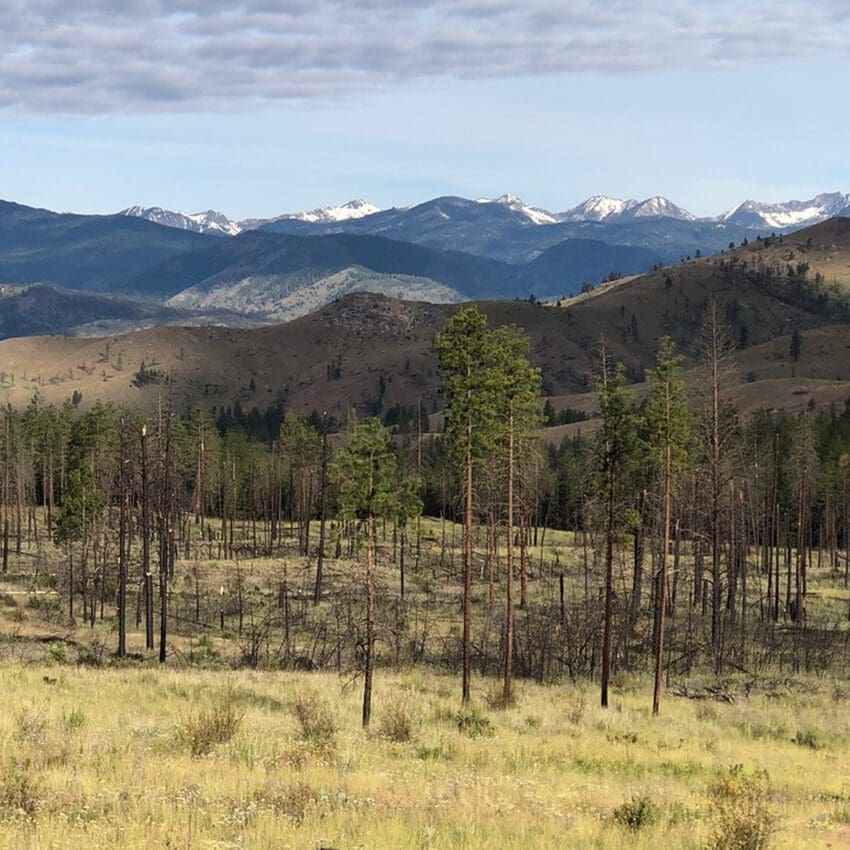

Landowner submitted photos before immediately after the Okanogan fire (left) and two years after seeding (right).
Recovering after a wild fire can be daunting. The memory of what our land looked like before the fire conflicts with the charred, barren moonscape that remains. We feel helpless against indiscriminate and unmerciful forces of nature that raze everything we have build. It is understandable that landowners are unsure of how to move forward. Feelings of helplessness and uncertainty remain long after the smoke has cleared.
We are here to help. Our hope is that we can offer wise consultation and quality, affordable seed in your efforts to recover your land after a fire. We will work to help you find solutions that aim to protect your property from the erosion and aftermath of fires. The guidelines below are general helps and are applicable in many post-fire situations in the western United States.
The purpose of this page is to help you:
- understand when to plant
- select the right seed species to recover the vegetation that was burned off
- prevent erosion
- mitigate or prevent future fires from having the same devastating effects
Seek advice from professionals with local knowledge:
Every geographic area in the country is served by a Natural Resources Conservation Service district (NRCS) or Farm Service Agency (FSA) office. They employ plant biologists, agronomists, soil scientists and a host of other trained professionals who can help you create a well rounded plan to reclaim your land after a fire. The USDA also has a Disaster Resource Center dedicated to preparing against and recovering from disasters, including fires.
The NRCS website has a webpage with offices broken down by state. We encourage you to reach out to them for boots-on-the-ground assistance. Once they help you formulate a plan and give seed recommendations give us a call. We can help you with the seed.
You can also call us directly for advise and assistance. We can make recommendations based on our experience and with help from our own experts.
When to Plant?
After a wildfire erosion control is a priority. Restoring ground cover and vegetation are the quickest and most effective long term solution for erosion control. Planting at the right time is crucial to plant establishment and soil stabilization. “Wildlands” or “range” seedings are usually most effective when sown in the fall or winter. Consider the natural life cycle of a plant: it blossoms in the spring or early summer, produces fruit (and seed) late summer and drops seed in the fall. The seeds either germinate and “crown out” then go dormant, or they lie dormant until spring when it germinates and grows into a new plant. The process repeats itself. Fall plantings most closely replicate that cycle. Fall plantings usually start in late september and run through october, but successful plantings can be sown as late as November and December.
While fall plantings are generally preferred, spring plantings work well also – don’t be discouraged or feel you can’t plant just because fall has passed. Try to get the seed on the ground as soon as possible so that it takes advantage of early spring moisture. Spring plantings are a good choice.
Most seeds can be planted any time of year assuming sufficient water is available to cary the plant through the germination cycle and early stages of growth.
What additional resources are available?
- USDA NRCS Fact Sheet, Vegetation Establishment for Soil Protection
- USDA NRCS Fact Sheet, Hydroseeding & Hydromulching for Erosion Control
- USDA NRCS Fact Sheet, Straw Mulching
- USDA NRCS Fact Sheet, Straw Bale Check Dam/Dike
- SDA NRCS Fact Sheet, Silt Fence
- Fire-Resistant Landscaping
- Forest Home Fire Safety
Fire Recovery by Geographic Areas and specific fires
In many cases, fires burned out long ago but the land recovery efforts continue. The information below are post-fire efforts that are ongoing in different parts of the country, and their web pages and resources are applicable in many fire situations.
Washington State Okanogan Conservation District help age
- WA State Okanogan Conservation District help page (webpage)
- Carlton Fire Resource Guide (pdf)
- Restoring Land After Fire (pdf)
- Carlton Seeding Recomendation (pdf)
- Flood After the Fire (pdf)
- Flood Brochure (pdf)
- Wildfire Risk Reduction (pdf)
- After The Burn (pdf)
- Fireline Rehab Strategies (pdf)
- Washington Fire Recovery website (webpage)
- Colorado State University “Action Plan” (webpage)
Incident Information: http://inciweb.nwcg.gov/incident/4534/
Methow Valley News: http://methowvalleynews.com
Wiki Page on Wahington State Wildfires: http://en.wikipedia.org/wiki/2015_Washington_state_wildfires
Soil Erosion Control after Wildfire: http://www.ext.colostate.edu/pubs/natres/06308.html or Download PDF
Seed Recommendations
Below are tables of recommended grasses, forbs (flowers) and shrubs that were previously recommended for wildfires in Washington State.
For the purposes of this fire help page, “irrigated” is any species that requires 16″ or more annual precipitation. If your area does not have at least 16″ then you should plan to irrigate or plant dryland or drought tolerant species. Many of Great Basin Seeds plant species are hand picked for their drought tolerance.
Recommended Grass Species
| Grass Species | H2O Needs | General Comments |
|---|---|---|
| Snake River Wheatgrass | Dryland | Great dryland species (introduced) |
| Intermediate Wheatgrass | Dryland | Establishes well, good for pasture |
| Hycrest Crested Wheatgrass | Dryland | Great dryland species (introduced) |
| Bluebunch Wheatgrass | Dryland | Great dryland species (native) |
| Siberian Wheatgrass | Dryland | Great dryland species (introduced) |
| Indian Ricegrass | Dryland | Establishes and persists in sandy, dry soil |
| Thickspike Wheatgrass | Dryland | Excellent sodformer for erosion control |
| Western Wheatgrass | Dryland | Great dryland species (native) |
| Russian Wildrye | Dryland | Great dryland species (introduced) |
| Basin Wildrye | Dryland | Great dryland species (native) |
| Sheep Fescue | Dryland | Excellent for disturbed sites (introduced) |
| Sand Dropseed | Dryland | Good for soil stabilization (native) |
| Smooth Brome | Dryland | Excellent for erosion control but can be weedy |
| Idaho Fescue | Dryland | Deep root system for erosion control (native) |
| Bottlebrush Squirreltail | Dryland | Excellent dryland choice (native) |
| Slender Wheatgrass | Dryland | Great high elevation species |
| Tall Fescue | Dryland | Establishes easy, needs water (introduced) |
| Needle and Thread Grass | Dryland | Excellent erosion control but pesky needles! |
| Sandberg Bluegrass | Irrigated | Establishes well, needs regular water (native) |
| Hard Fescue | Dryland | Requires more water than Sheep Fescue |
| Prairie Junegrass | Dryland | An excellent choice but cost prohibitive |
| Orchardgrass | Irrigated | Except for “Paiute” variety it needs irrigation |
| Perennial Ryegrass | Irrigated | Needs irrigation to thrive |
| Tall Wheatgrass | Dryland | Establishes in saline areas, not good forage |
| Annual Ryegrass | Irrigated | Fast establishing, short lived annual |
Recommended Forbs and Flowers
| Forbs & Legumes | H2O Needs | Notes |
|---|---|---|
| Yellow Sweetclover | Dryland or Irrigated | Fast establishing bi-annual, good erosion control |
| Lewis Blue Flax | Dryland | Showy perennial, good erosion control |
| Sainfoin | Dryland or Irrigated | |
| Small Burnet | Dryland or Irrigated | |
| Small Flower Globemallow | Dryland | |
| Munro’s Globemallow | Dryland | |
| Annual Sunflower | Dryland | |
| Lander Alfalfa | Dryland or Irrigated | |
| Palmer’s Penstemon | Dryland | Thrives in disturbed soils, persistent after fire |
| California Poppy | Dryland or Irrigated | |
| Strawberry Clover | Dryland or Irrigated | Tolerates saline soils |
| Alsike Clover | Dryland or Irrigated | |
| Red Clover | Dryland or Irrigated | |
| Perennial Gaillardia | Dryland | |
| Silvery Lupine | Dryland | |
| Showy Goldeneye | Dryland | |
| White Dutch Clover | Dryland or Irrigated | |
| Ladino Clover | Dryland or Irrigated | |
| Gooseberryleaf Globemallow | Dryland | |
| Firecracker Penstemon | Dryland | |
| Rocky Mountain Beeplant | Dryland or Irrigated | |
| White Yarrow | Dryland or Irrigated |
Recommended Shrub Species
| Shrubs | H2O Needs | Notes |
|---|---|---|
| Antelope Bitterbrush | Dryland | |
| Cliffrose | Dryland | |
| Blue Elderberry | Dryland or Irrigated | |
| Greasewood | Dryland | |
| Forage Kochia | Dryland | |
| Curl Leaf Mahogany | Dryland | |
| Birchleaf Mahogany | Dryland | |
| Rubber Rabbitbrush | Dryland | |
| Woods Rose | Dryland or Irrigated | |
| Basin Big Sagebrush | Irrigated | |
| Mountain Big Sagebrush | Dryland | |
| Wyoming Big Sagebrush | Dryland | |
| Fourwing Saltbrush | Dryland | |
| Shadscale Saltbrush | Irrigated | |
| Western Wheatgrass | Dryland or Irrigated | |
| Skunkbush Sumac | Dryland or Irrigated | |
| Winterfat | Dryland |